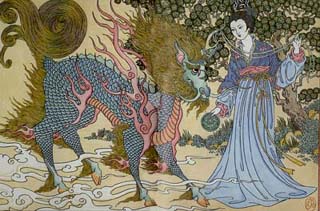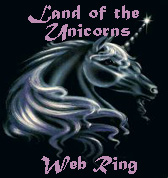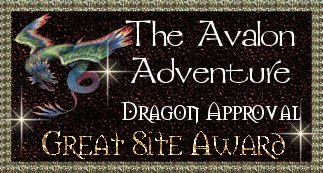 Unicorn Page Unicorn Page 

This page will be maintained as long as it possible.
Here, in this hidden shadowed place lies the beginning of the mystical path of unicorn's lore.
|
Unicorns, - who are they? Commonly they are described as mythical creatures
with a horse body, white fur, and a twisted horn on the forehead. With small
variations this conception is present practically everywhere in reference
literature. So, is a unicorn really just only a white horse with a horn and
nothing more? Do you believe it? I don't! Surely it isn't...
|

History of unicorns
Unicorns have been with us since the dawn of history. However there is no one "true" version of
the unicorn legend - modern conception of unicorn is a result of handed down stories and tales
from one generation to another. In other words, there is no one "correct" version of the unicorn,
 although there are general guidelines which make up a sort of composite of what a unicorn is like.
They were first described in China about 26 century B.C. as a
miraculous creature called the k'i-lin that radiated exquisite colors, had a
voice like the tinkling of bells, and lived for a thousand years. He was honoured as the king of
the land animals. Although his body-type more likely a dragon with fish scales that shimmer in
every colour of the rainbow, it does have a mane and cloved hooves as well. This unicorn brought
important messages to human beings: K'i-lin was observed in 2697 BC for the first time as it wandered
through the palace of the emperor Huang-ti. This was seen as the announcement of lucky years.
People say that in the following years Huang-ti invented music instruments, taught his people how
to build houses with bricks and united the Chinese tribes for the first time. The k'i-lin showed
itself to the emperor at the end of his life for a second time to carry him to the land of the
dead on its back.
although there are general guidelines which make up a sort of composite of what a unicorn is like.
They were first described in China about 26 century B.C. as a
miraculous creature called the k'i-lin that radiated exquisite colors, had a
voice like the tinkling of bells, and lived for a thousand years. He was honoured as the king of
the land animals. Although his body-type more likely a dragon with fish scales that shimmer in
every colour of the rainbow, it does have a mane and cloved hooves as well. This unicorn brought
important messages to human beings: K'i-lin was observed in 2697 BC for the first time as it wandered
through the palace of the emperor Huang-ti. This was seen as the announcement of lucky years.
People say that in the following years Huang-ti invented music instruments, taught his people how
to build houses with bricks and united the Chinese tribes for the first time. The k'i-lin showed
itself to the emperor at the end of his life for a second time to carry him to the land of the
dead on its back.

Not only in Eastern (Chinese and Japanese) history can we meet with
unicorns, but there also exist many western legends about these beings. It seems that practically every culture has
a myth about a "Horn of Plenty" which spills out an unlimited amount of food, but the origins of this legend aren't
well known. The concept of the "Horn of Plenty" is actually linked with unicorn legends. In Greek legend, the god
Zeus was nursed by a goat named Amalthea. In one version of this legend, he broke off one of her horns, making her
a uni-horned goat. The horn that had been broken off began to spill forth a bounty of food. This probably connects to
the midieval idea of the unicorn's horn having magical curing powers. There is also a link between this myth and our
reality: In the sky is the star "Capella" which in Latin means "Goat." One legend about Amalthea states that she was
transformed into a star by Zeus in gratitude for all she had done. The origins of many other legendary beasts also lie in
Greek mythology, but that is another story.

Chapter three: Middle Ages
Even though the legend of unicorns has come from Chinese or Greek
mythology, they are probably best known and held in high esteem from the Middle Ages of Europe. It was the
greatest of times - a time of knights and dragons; a time when our world was still clean and young. As a result of
factors including unintegrated society, the absence of modern technology, and the small human population,
myth and reality existed together for the people of the Middle Ages. Practically all people believed in
the existance of some mystical beings like dragons and unicorns. For them, the existance of these
 beasts was as certain as the stories in the Holy Bible (the unicorn was sometimes used as a representation of Christ:
on one Midieval tapestry about a unicorn hunt, you can see how
the unicorn purifies a fountian of water with his horn. It is symbolising Christ's cleansing of humanity's sins).
Generally, unicorns symbolized things such as chastity, purity, cleanliness and honesty. The magical curative
power of it's horn made unicorns a desired animal to hunt. But, a unicorn could only be captured by a virgin.
For a unicorn, there is nothing worse than the loss of it's freedom. They were so proud that they would not survive
captivity. Only one thing made them valuable to hunt - the horn. It was believed that if any poisoned food was
brought near the unicorn's horn, the horn would begin to bleed. Also, waving it over food or drink, or including
powdered horn in the food would neutralize any kind of poison. Rulers and noble men, as you probably know,
were ever afraid of being poisoned. It is easy to understand why they wished to possess the unicorn's horn. This
created big business for bad men - at the time fake 'unicorn's horns' carved from ivory or narwhale horns were sold.
Maybe, the supposed healing power of the horn made the unicorn a symbol of medicine. Even today, you can find
pictures of unicorns in old medical books.
beasts was as certain as the stories in the Holy Bible (the unicorn was sometimes used as a representation of Christ:
on one Midieval tapestry about a unicorn hunt, you can see how
the unicorn purifies a fountian of water with his horn. It is symbolising Christ's cleansing of humanity's sins).
Generally, unicorns symbolized things such as chastity, purity, cleanliness and honesty. The magical curative
power of it's horn made unicorns a desired animal to hunt. But, a unicorn could only be captured by a virgin.
For a unicorn, there is nothing worse than the loss of it's freedom. They were so proud that they would not survive
captivity. Only one thing made them valuable to hunt - the horn. It was believed that if any poisoned food was
brought near the unicorn's horn, the horn would begin to bleed. Also, waving it over food or drink, or including
powdered horn in the food would neutralize any kind of poison. Rulers and noble men, as you probably know,
were ever afraid of being poisoned. It is easy to understand why they wished to possess the unicorn's horn. This
created big business for bad men - at the time fake 'unicorn's horns' carved from ivory or narwhale horns were sold.
Maybe, the supposed healing power of the horn made the unicorn a symbol of medicine. Even today, you can find
pictures of unicorns in old medical books.

I've spent almost a full year creating this chapter. History did not expire
somewhere in the middle ages - it actually never comes to an end and never will end. History is a process
that will continue for eternity. But it isn't so simple to understand and to see that even today, it is possible
that you could meet with a unicorn (It is necessary to search, and to believe :)) At least I can tell you one
 thing - unicorns live in the human soul for anyone who carries their image inside of themselves.
thing - unicorns live in the human soul for anyone who carries their image inside of themselves.
Upon contemplation our modern situation and researching on the Net, it appears that there is a belief that
humanity is not just a strange kind of animal destroying everything in it's path. There is still hope. There are,
not hundreds of pages devoted to unicorns and not thousands - but rather tens of thousands!!! Not all of the
websites are good and some of them are pretty frightening, but the majority are created from the heart. The
existence of the Net gives many people an opportunity and the courage to express their innermost thoughts
and feelings. They might not have expressed these feelings without the Net because of the fear of being
misunderstood or derided. The Net gives an opportunity to meet others like yourself and not feel lonliness,
and not to suffer the torment that you're the only one (as I felt for a long time). It also gives an opportunity to
stretch your wings...
As I have seen, the modern chapter about unicorns started with
 a great book of our time, "The Last Unicorn" by Peter S. Beagle. There is also a great movie with the same
name which was created by men, who have obviously known and felt what they do. There is real magic in
both the book and the movie. It is a pity that not all people are capable of feeling and understanding that magic.
Maybe it is not given to everyone, or more precisely, not necessary for everyone? But I, personally, was
acquainted with unicorns, not from the book - which I read for the first time in June 1999 - and not from the
film - which I first saw in 1996. I knew unicorns earlier. But all these works of art had left an indelible
impression, opened new horizons, and even helped me to look at the world in a new fashion. There is a
separate page that I have devoted to the film "The Last Unicorn" which you can view by clicking
here...
a great book of our time, "The Last Unicorn" by Peter S. Beagle. There is also a great movie with the same
name which was created by men, who have obviously known and felt what they do. There is real magic in
both the book and the movie. It is a pity that not all people are capable of feeling and understanding that magic.
Maybe it is not given to everyone, or more precisely, not necessary for everyone? But I, personally, was
acquainted with unicorns, not from the book - which I read for the first time in June 1999 - and not from the
film - which I first saw in 1996. I knew unicorns earlier. But all these works of art had left an indelible
impression, opened new horizons, and even helped me to look at the world in a new fashion. There is a
separate page that I have devoted to the film "The Last Unicorn" which you can view by clicking
here...


They and I
From where have I known the unicorns - the mysterious fantastic essence, the
memory which has come to us from an ancient time? It is a simple enough story. Until recently in Russia,
where I reside, it was only possible to find little parts of information about unicorns. In general, or to be
more exact, until 1992, I couldn't see either books or films mentioning the creature. In 1992 in our country
the Roger Zelazny book "Chronicles of Amber" was translated and printed in our language. It was from this
book which I first heard about a unicorn. The book was in rather bad condition and it did not contain any
illustrations. In truth, I sometimes thought the unicorn was a beast like a rhinoceros. After some time, the
book was translated and issued by another publishing house. It came into my hands in one small shop of my
university and on the cover was an image! The picture was very nice and I liked it a lot. It was the first time
I had ever seen a unicorn. I can't exactly describe what happened at that moment as such strange feelings
appeared in my soul. It was like spring in the forest - like an awakening... Or maybe it was not the first time,
but only a reminder...

Several of beloved pages...




Last update January 19, 2003.
Great thanks to Liz for help in linguistic aspects.

This page hosted by  Get your own Free Home Page
Get your own Free Home Page
|
 Unicorn Page
Unicorn Page 







 Get your own Free Home Page
Get your own Free Home Page
 although there are general guidelines which make up a sort of composite of what a unicorn is like.
They were first described in China about 26 century B.C. as a
miraculous creature called the k'i-lin that radiated exquisite colors, had a
voice like the tinkling of bells, and lived for a thousand years. He was honoured as the king of
the land animals. Although his body-type more likely a dragon with fish scales that shimmer in
every colour of the rainbow, it does have a mane and cloved hooves as well. This unicorn brought
important messages to human beings: K'i-lin was observed in 2697 BC for the first time as it wandered
through the palace of the emperor Huang-ti. This was seen as the announcement of lucky years.
People say that in the following years Huang-ti invented music instruments, taught his people how
to build houses with bricks and united the Chinese tribes for the first time. The k'i-lin showed
itself to the emperor at the end of his life for a second time to carry him to the land of the
dead on its back.
although there are general guidelines which make up a sort of composite of what a unicorn is like.
They were first described in China about 26 century B.C. as a
miraculous creature called the k'i-lin that radiated exquisite colors, had a
voice like the tinkling of bells, and lived for a thousand years. He was honoured as the king of
the land animals. Although his body-type more likely a dragon with fish scales that shimmer in
every colour of the rainbow, it does have a mane and cloved hooves as well. This unicorn brought
important messages to human beings: K'i-lin was observed in 2697 BC for the first time as it wandered
through the palace of the emperor Huang-ti. This was seen as the announcement of lucky years.
People say that in the following years Huang-ti invented music instruments, taught his people how
to build houses with bricks and united the Chinese tribes for the first time. The k'i-lin showed
itself to the emperor at the end of his life for a second time to carry him to the land of the
dead on its back.
 beasts was as certain as the stories in the Holy Bible (the unicorn was sometimes used as a representation of Christ:
on one Midieval
beasts was as certain as the stories in the Holy Bible (the unicorn was sometimes used as a representation of Christ:
on one Midieval  thing - unicorns live in the human soul for anyone who carries their image inside of themselves.
thing - unicorns live in the human soul for anyone who carries their image inside of themselves.
 a great book of our time, "The Last Unicorn" by Peter S. Beagle. There is also a great movie with the same
name which was created by men, who have obviously known and felt what they do. There is real magic in
both the book and the movie. It is a pity that not all people are capable of feeling and understanding that magic.
Maybe it is not given to everyone, or more precisely, not necessary for everyone? But I, personally, was
acquainted with unicorns, not from the book - which I read for the first time in June 1999 - and not from the
film - which I first saw in 1996. I knew unicorns earlier. But all these works of art had left an indelible
impression, opened new horizons, and even helped me to look at the world in a new fashion. There is a
separate page that I have devoted to the film "The Last Unicorn" which you can view by clicking
a great book of our time, "The Last Unicorn" by Peter S. Beagle. There is also a great movie with the same
name which was created by men, who have obviously known and felt what they do. There is real magic in
both the book and the movie. It is a pity that not all people are capable of feeling and understanding that magic.
Maybe it is not given to everyone, or more precisely, not necessary for everyone? But I, personally, was
acquainted with unicorns, not from the book - which I read for the first time in June 1999 - and not from the
film - which I first saw in 1996. I knew unicorns earlier. But all these works of art had left an indelible
impression, opened new horizons, and even helped me to look at the world in a new fashion. There is a
separate page that I have devoted to the film "The Last Unicorn" which you can view by clicking


 Picture gallery
Picture gallery The Last Unicorn
The Last Unicorn Unicorn Rings
Unicorn Rings Back to main page
Back to main page

